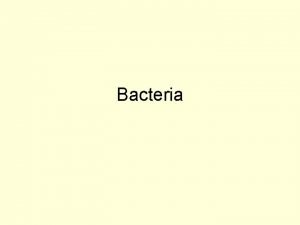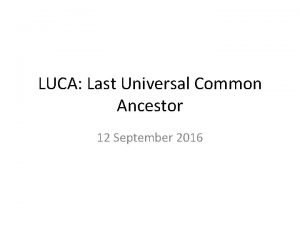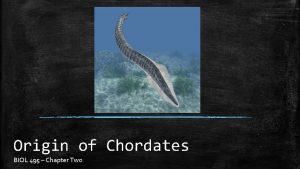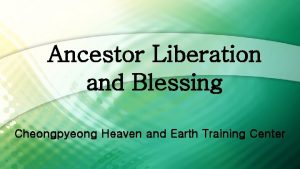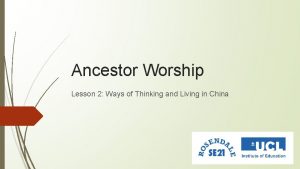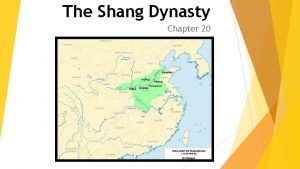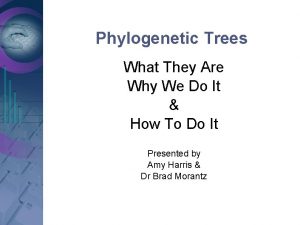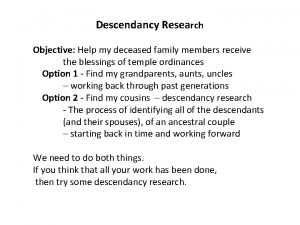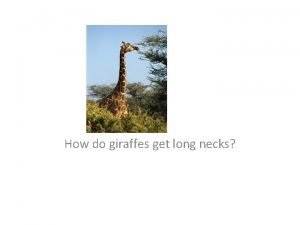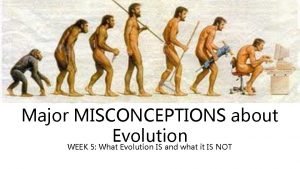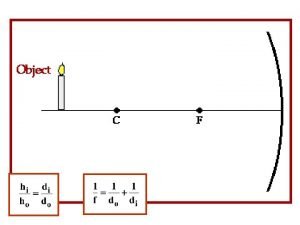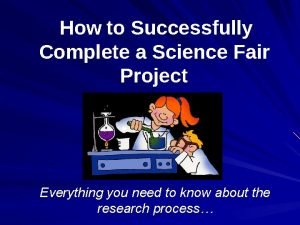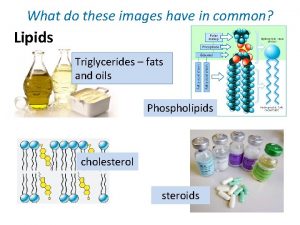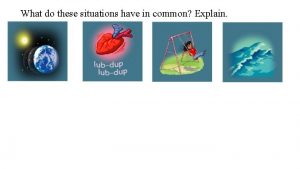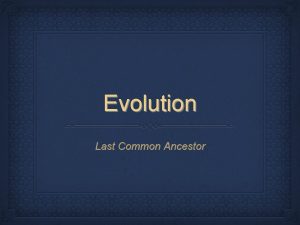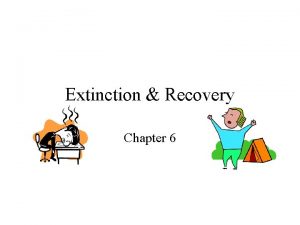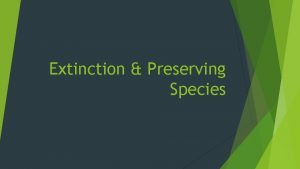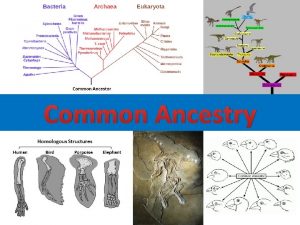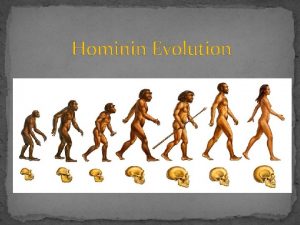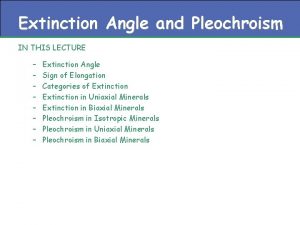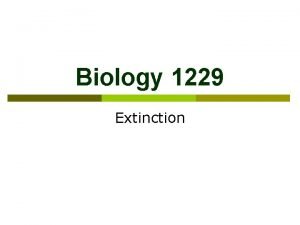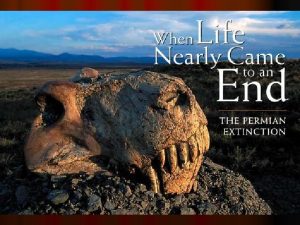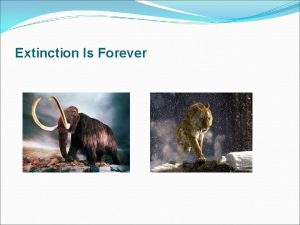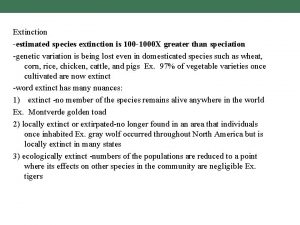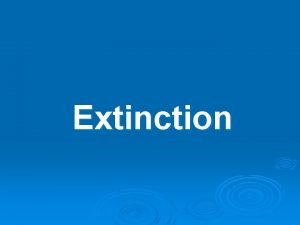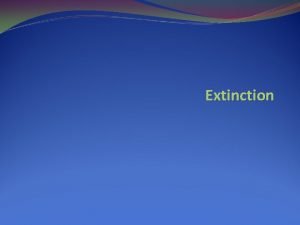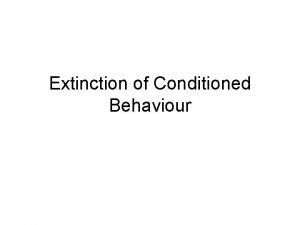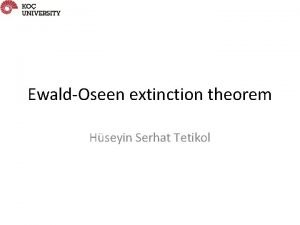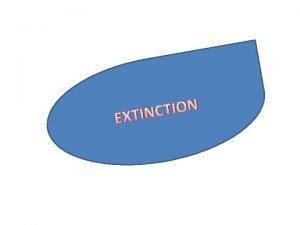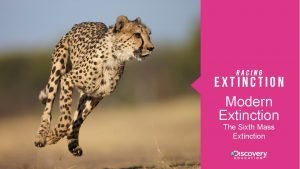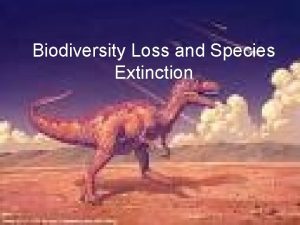Evolution The Changes Common Extinction Images Ancestor Theory



























- Slides: 27

Evolution

The Changes Common Extinction Images Ancestor Theory 100 100 100 200 200 200 300 300 300 400 400 400 500 500 500

The Theory – 100 Evidence that best supports theory of biological evolution was obtained from the A) Investigation of environmental niches B) Study of fossil record C) Comparison of the number of cells in organisms D) Analysis of food chains and food webs B) Study of fossil record

The Theory - 200 According to theory of natural selection, why are some individuals are more likely to survive and reproduce A) New characteristics are passed on to offspring B) Some are better adapted to environment C) Some do not want to pass on new characteristics D) Fewer offspring are produced B) Some are better adapted to environment

The Theory - 300 Which best supports theory of evolution A) Genetic alternation occur each reproduction of cells B) Fossil record provides samples of every organism that has ever lived C) Populations that have advantageous characterists will increase in number B) Fossil record provides samples of every organism that has ever lived.

The Theory - 400 Overproduction struggle for survival of the fittest changes of species A) Natural Selection B) Genetic Manipulation C) Dynamic Equilibrium D) Material Cycle A) Natural Selection

The Theory - 500 According theory of natural selection, why are some individuals more likely than other to survive and reproduce? A) Some individuals pass on to their offspring new characterists they have acquired during their lifetimes B) Some individuals are better adapted to exist in their environment than others are C) Some individuals tend to produce fewer offspring than others in the same environment B) Some individuals are better adapted to exist in their environment than others are

Changes - 100 Exposure to mutagens can promote A) Production of similar organisms B) Diversity among organisms C) An increase in population size D) Change from sexual to asexual reproduction B) Diversity among organisms

Changes - 200 Galapagos finches evolved partly due to A) Variation and Competition B) Migration and selective breeding C) Mutations and asexual reproduction D) Cloning and recombination A) Variation and Competition

Changes - 300 Species of bacteria can evolve more quickly that species of mammals because bacteria have A) Less competition B) More chromosomes C) Lower mutation rates D) Higher rates of reproduction

Changes - 400 After spreading plant killer, some plants survived. Those that are resistant most likely survived due to A) Super powers B) Mutations C) Plant killer genes in plant D) Break in the food web B) Mutations

Changes - 500 Fish have gills, earthworms absorb oxygen through skin, bacteria absorb oxygen through membrane, these are examples of A) Same process through different methods B) Same process through same method C) Different process through different method D) Different process through same method A) Same process through different methods

Common Ancestor – 100 Which of the following are most closely related? A) A and E B) E and C C) B and C D) D and E

Common Ancestor - 200 We can compare ______ and ______ to create phylogenetic trees. A) Reproductive rate, adaptive value B) Population size, environment C) Vestigial structures, overproduction D) Proteins, DNA D) proteins, DNA

Common Ancestor - 300 Which species have the most similar DNA sequence? A) A & C B) C & D C) D & B D) A & B

Common Ancestor - 400 D & E are more closely related than D & C because D & E are A) similar in appearance B) Similar in environment C) Similar in ancestry D) Similar in hemoglobin C) Similar in ancestry

Common Ancestor - 500 Thousands of years ago, giraffes with short necks were common, now most giraffes have long necks. The change can be due to, A) Mutation in genetic material in sex cells B) Mutation in genetic materials in neck cells C) Giraffes stretching necks to get to food D) Giraffes stretching necks to keep head above predators A) Mutation in genetic material in sex cells

Extinction - 100 When a species becomes extinct that allows for increased A) Niches avalible for other species B) Adaptive value in that species C) chances of environmental change A) available niches for other species

Extinction - 200 A species that lacks the variation needed to adapt is more likely to A) Develop super powers B) Change reproductive types C) Develop mutated cells D) Become extinct over time.

Extinction - 300 Endangered species are being bred in captivity and released, this is an example of A) Overhunting and direct harvesting B) Species preservation and biological control C) Recycling and technological development D) Conservation of resources and habitat destruction B) Species preservation and biological control

Extinction - 400 Extinction of a species is most commonly due to A) Overproduction B) Adaptive Value C) Environmental Change D) Mutation C) Environmental Change

Extinction - 500 The Dodo bird is extinct, which is the most likely reason? A) Change in the environment B) Increased predation C) Mutations cause death D) Better suited bird replaced it A) Changes in the environment

Images - 100 These two different species of bears have different traits, which best explains how these differences came about? A) The polar bear preferred colder temperatures B) Each developed differently to prevent overpopulation C) Differences in appearance appeared as they adapted to different environments D) They ancestors were trying to avoid competition C) Differences in appearance appeared as they adapted to different environments

Images - 200 These finches have different beaks because they adapted A) Because birds with big beaks became dominant B) To find different food sources C) Because yellow beaks allowed for camouflage D) To have cooler beaks to attract mates B) To find different food sources

Images - 300 Z is most likely: A)Certhidea B) Geospiza C) Camarhynchus D) Platyspiza C) Camarhynchus

Images - 400 The similarities in these bones is most likely due to A) Development from same earlier species B) Development in common environment C) Identical genetic makeup D) Identical methods of obtaining food A) Developed from same earlier species

Images - 500 The change from fins in fish to legs and feet in amphibians was most likely due to A) Sudden mutation that changed gills to lungs B) Increased competition for food in water C) Variations among offspring leading to natural selection
 Emblem
Emblem Contrast gymnosperms and angiosperms
Contrast gymnosperms and angiosperms Last universal common ancestor
Last universal common ancestor What is the last universal common ancestor
What is the last universal common ancestor Changes in latitudes, changes in attitudes meaning
Changes in latitudes, changes in attitudes meaning What's a physical change
What's a physical change Ancestor of chordates
Ancestor of chordates Prayer before class
Prayer before class Dae mo nim
Dae mo nim Abacus komputer
Abacus komputer Cheongpyeong ancestor liberation
Cheongpyeong ancestor liberation Mulan ancestor shrine
Mulan ancestor shrine Shang dynasty weapons
Shang dynasty weapons Ancestor tree
Ancestor tree Ancestor
Ancestor Horse evolution fossils
Horse evolution fossils Descendancy research
Descendancy research Modern theory of evolution
Modern theory of evolution Phase changes
Phase changes Common misconception about evolution
Common misconception about evolution Virtual vs real image
Virtual vs real image Hi
Hi Https://images.search.yahoo.com
Https://images.search.yahoo.com How to save images on google images
How to save images on google images Yahoo.com.yw
Yahoo.com.yw What do these images have in common
What do these images have in common What do they have in common ? explain
What do they have in common ? explain What do all of these pictures have in common?
What do all of these pictures have in common?


